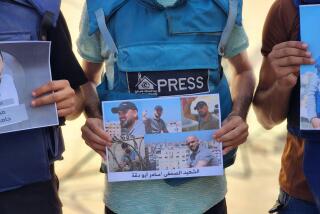The <i> Other</i> Middle East Conflict
- Share via
JERUSALEM — The subject is coverage of the West Bank and Gaza Strip turbulence--and the censure of some American news media for allegedly distorting and exacerbating the story.
“I’d say our credibility is on a par with Tass,” said Robert Wiener, bureau chief here for Cable News Network.
Tass should sue Wiener for giving it a bad name. Even the Kremlin-serving Soviet news agency hasn’t been hit by the number of critical salvos that legions of irate Israelis and American Jews have lobbed at media covering the violence in the once-Arab territories where Palestinians are protesting Israel’s occupation.
American television--with its awesome reach and visual impact--is labeled the main villain in this clobber-the-messenger scenario. But the Los Angeles Times and other American publications have also been heavily criticized at home for their reporting here.
Network bureau chiefs claim it’s unfair, given the time limits of TV news, to judge on a daily basis whether coverage is balanced or unbalanced or in historical context. NBC Bureau Chief Mauri Moore speaks for her counterparts when she says: “If you took our coverage and strung it together, you’d find it fair.”
That presupposes, of course, that a typical viewer watches all of a network’s newscasts. And the time restrictions under which the networks operate are of their own making.
Charges against the media range from anti-Israel bias to TV cameras causing disturbances and violence merely by their presence.
Central to the rap against TV is the character of the medium itself and the relationship of pictures to words.
When applied to an arena as fluid, volatile and complex as today’s Israel, in particular, TV tends to omit nuances and shadings in favor of blacks and whites, elevating the immediate and superficial above reflection. There are times when TV seems to move faster than conscious thought, dishing up crises on electronic flashcards that are crammed into 22-minute news holes, leaving an impression only with their visual images.
Consider one of the major accusations against the news media here, TV especially: that they create the impression that Israeli soldiers are shooting, tear-gassing, roughing up and generally abusing Palestinian demonstrators without provocation.
There is provocation in most cases. Those stones that Palestinians have been heaving at Israeli soldiers and some of the media can break heads as well as car windows. And the media insist that they have pointed that out.
“The most erroneous claim made against us is that we don’t show the provocation,” said ABC correspondent Dean Reynolds. “But I have done that on every spot. It’s the visualization they (critics) object to. It’s stones against guns.”
Added CNN correspondent Mike Greenspan: “Even if you mention the provocation, Palestinians are the underdogs, visually, and the Israelis look like they’re brutal, trampling on defenseless people.”
Watching American TV, some viewers have gotten the wrong impression, too, that the occupied lands--if not all of Israel--are ablaze.
“I have gotten calls from friends at home who say it looks like the whole place is exploding,” Wiener said. “If that’s true, then someone is not doing their job.”
“Even if you say that most places are quiet, the viewer will not remember those words,” Greenspan said. “He’s going to remember those stones flying.”
“It’s the nature of TV that you don’t remember any images but the active images,” according to NBC’s Moore. “So we in TV go out and get the images that people remember. But we also put in those thoughtful sound bites.”
Which people don’t remember?
“What people remember is the bang-bang,” Moore said.
That wouldn’t be so if there were less bang-bang on the screen. But TV--which rarely devotes more than two minutes to any story--is tailored to action, not serenity or thoughtfulness, be the subject Central America or the Middle East.
“The violence is the story, and not the calmness,” said Bill Seamans, who heads ABC’s Jerusalem bureau, which he opened in 1967.
In any event, if TV has its peculiar nature, so do TV viewers and newspaper readers.
We all tend to approach situations subjectively, with preconceptions drawn from our biases and life experiences. In other words, we often see what we want to see and read what we want to read regardless of the reality.
That has surely been the case with some critics of West Bank and Gaza Strip coverage.
ABC’s Seamans recently held a consciousness-raising session for some Israeli army officers upset about TV coverage of the uprisings. “They said we didn’t show the Arabs throwing stones and firebombs at the Israelis,” Seamans said.
He proved them wrong, he said, by showing them samples of ABC’s coverage.
“You know,” Seamans said, “I have been on the scene of every major terrorist attack (in the Middle East) since 1967. And we did nothing differently then (in coverage) than what we’re doing now. But nobody ever complained then the way they are complaining now.”
What some members of the Israeli government may be seeking from the American media they have severely criticized is not objectivity but support.
Several TV journalists here reported getting that message from government members.
“Dean, you’re not sympathetic,” are the words one high-ranking Israeli official used to admonish Reynolds, the ABC correspondent recalled.
“Well, my job is not to be sympathetic,” Reynolds said. “They think we are friends, and we are. But they think the press is supposed to be a booster, which we’re not.”
Reynolds said he tries not to let bias charges affect him: “I look at this story as sort of a civil rights story, and I don’t see how Israel can come out ahead, given the facts of the uprising.”
Those “facts” include an unofficial government policy of soldiers sometimes beating demonstrators as an alternative to shooting.
“The policy of beating is so incredible,” Wiener said. “We would go out and see these people who were severely beaten, limbs broken, bodies broken. This stuff comes back, and you see it day after day.”
Seamans has a theory about the intense anti-media backlash. It concerns state-run Israel Television, which some Israelis and Americans here have accused of sanitizing coverage of the uprisings--a charge rejected by Chaim Yavin, who heads the Israel Broadcasting Authority.
“Israel had never seen these things (army violence against Palestinians) because Israel Television was literally lying to the public about what was happening in the territories,” Seamans said. “Israelis first saw the beatings on Jordanian TV (which is available in Israel).
“So here are Israelis shocked at seeing nice Jewish boys beat the hell out of Arabs, behaving like soldiers everywhere, not like the Israeli ideal. And instead of getting mad at themselves, they turned on the messenger.”
The media have also been accused of being manipulated by the Palestinians. And it’s hard finding anyone in American TV here who believes that at some point demonstrators have not been able to exploit cameras. There’s no question, moreover, that repeated footage of clashes between heavily armed Israeli soldiers and rock-throwing youths have lifted Palestinians to a new level of sympathy in the West.
But TV journalists reject the label of provocateur .
They note that demonstrations occur regardless of TV’s presence and that Palestinian deaths and casualties continued to mount in the occupied territories even during the government’s recent three-day ban on media coverage there.
In fact, all the networks have official or unofficial policies concerning use of cameras at demonstrations. The one at CBS is typical. “It’s CBS policy to turn off cameras at the slightest hint that we are contributing to a demonstration,” said the network’s bureau chief, Terrell Platinga.
“Look, if you take a camera crew and put them out there, people are going to react,” CNN’s Greenspan said. “I know of a foreign film crew that drove into a refugee camp, took out a camera to film some scenes and all hell broke out. People burned tires and started demonstrating. But if a crew works judiciously, it can minimize that.”
So, ultimately, there are two conflicts the media are immersed in here. One is between Palestinians and Israelis, the other between the media themselves and their critics.
And both are draining.
“I’ve never worked harder in my life,” said Wiener, whose present Israel tour began in June. “The hours are killers, from 9 a.m. to 1 a.m. In the last 114 days, I’ve had five days off. You have to work your Atlanta day (where CNN is based) and your Israel day--the violence, the demonstrations. It’s a very debilitating story, and it wears you down.”
Reynolds has been here 18 months. “Mentally and emotionally, I feel real bad about everything,” he said. “This is a beautiful country, a wonderful idea. But there’s lots of sadness. Both sides have their points, and it’s irreconcilable. All of this is going to go on and on and on.”
Both conflicts, more than likely.
More to Read
The complete guide to home viewing
Get Screen Gab for everything about the TV shows and streaming movies everyone’s talking about.
You may occasionally receive promotional content from the Los Angeles Times.






